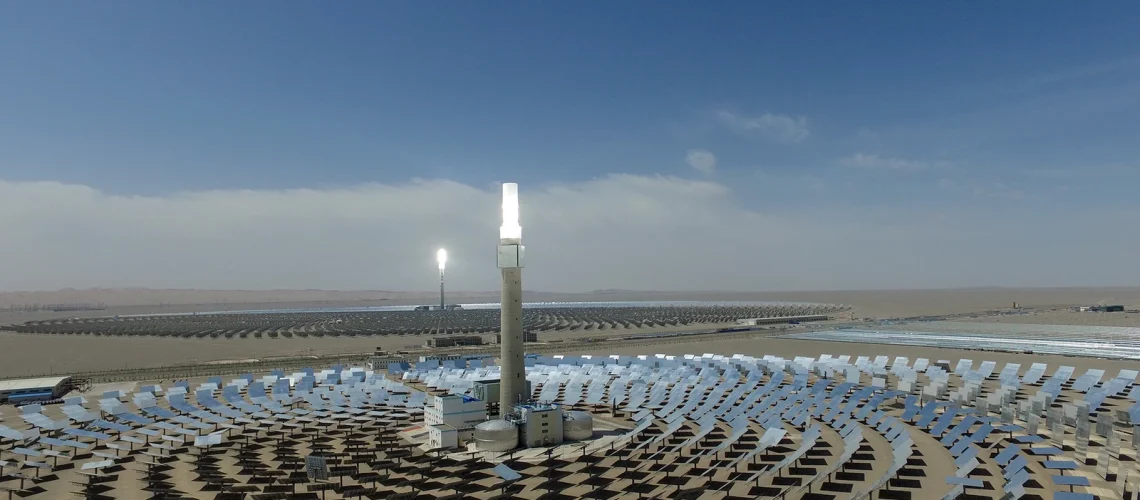Source: https://www.pacificgreen-group.com/
Sunny weather, vast open spaces and a growing need for dispatchable clean energy. We have said it before: Australia is perfect for concentrated solar power (CSP). Yet the technology has struggled to make an impact, with only a limited number of small projects having entered production.
The reasons why this market has been so challenging for CSP probably have more to do with the nascent nature of early project designs than any inherent flaw in the technology. At Pacific Green we firmly believe CSP deserves another roll of the dice in Australia.
Then again, we would say that: we are in the business of building CSP plants, after all. But what of the numbers? Does CSP make sense in a country where solar photovoltaic (PV) has such a good payback that around a third of detached homes already have panels installed?
To find out, let’s look at the numbers. In 2020, the analyst firm BloombergNEF published global levelised cost of energy (LCOE) figures for a range of generation technologies—not including CSP—which RenewEconomy reported on in an Australian context.
The cheapest form of electricity generation at the time was tracking PV, which BloombergNEF estimated would have an LCOE of USD$26 to $67 per megawatt-hour (MWh). Fixed-axis PV was almost as cheap, at $29 to $80 per MWh. Onshore wind came in at $32 to $83 per MWh.
These renewable generation figures compared favorably to fossil fuel plants. Combined cycle gas turbine (CCGT) plants, with an LCOE of $66 to $96 per MWh, were at least two and a half times more expensive than the cheapest tracking PV installations.
And open cycle gas turbine (OCGT) power plants, with an LCOE of $146 to $309 per MWh, were roughly six to 12 times more costly.
The catch is that comparing PV or wind to gas is not quite fair, because the latter can be ramped up whenever you need it while the former depend on the availability of sunshine or windy weather.
To make this an apples-to-apples comparison, you need to add the cost of batteries to wind or solar plants. But even then, the renewables are competitive.
According to BloombergNEF, the LCOE for an onshore wind with battery storage would work out at $50 to $124 per MWh, overlapping the range calculated for CCGTs and still below the LCOEs for OCGTs. Fixed-axis PV and storage had an LCOE range of $58 to $178, still competitive with gas.
These figures are all from over a couple of years ago and so might not apply to today’s situation. Under usual circumstances, the cost of renewables and batteries might be expected to have fallen, while that of gas would have more or less stayed the same. That has not happened.
Last year, because of problems with polysilicon supply, the cost of PV started to go up after falling 90% in the previous decade. Solar PV is still cheap, but probably not much cheaper now than it was in 2020—if that.
Battery prices have not fallen much in recent months either, so the renewables-plus-storage figures from BloombergNEF a couple of years ago are probably not too far off the mark today.
And cost increases have been even more pronounced in gas, because of shortages caused by the crisis in Ukraine. After barely hitting AUD$10 a gigajoule in the previous decade, Australian gas prices have soared to around $25 per gigajoule in recent months.
Based on this, BloombergNEF’s 2020 figures for CCGTs and OCGTs are likely to be highly optimistic today. How does CSP compare to all this? Before looking at the data, it is worth pointing out that CSP is not really a competitor to PV or wind, but certainly is for gas.
Today’s CSP plants are designed to act as huge solar batteries, storing heat from the sun in massive tanks of molten salt so it can be used to provide electricity whenever needed.
In this respect, CSP today takes on a similar role to CCGTs and OCGTs, filling in when cheaper renewable energy is not available.
The output of CSP plants is mainly dependent on a measure of sunshine called direct normal irradiance, which in Australia can average around 2,500 kW per square meter per year.
If equipped with 12 hours of molten salt storage, a 100 MW parabolic trough plant—the most widely used form of CSP today—could achieve an LCOE of less than USD$100 per MWh, beating OCGTs by a wide margin and potentially matching CCGTs at today’s high gas prices.
A more advanced form of CSP, using a so-called power tower design, could achieve an even better LCOE.
Once more assuming a 100 MW plant with 12 hours of thermal storage, the power tower could deliver energy at $70 per MWh, easily matching most CCGT plants and plenty of PV or wind plants with batteries too.
The one small drawback of power tower designs is that they require more land than parabolic trough plants. A 100 MW power tower in Australia would occupy 427 hectares, compared to 324 hectares for a parabolic trough plant of similar capacity.
In some situations, this discrepancy might be a problem. But in Australia, where the availability of land is not an issue, it is hard to see an extra 100 hectares being a showstopper. Indeed, most of the plants that have been proposed on Australian soil have been of the power tower variety.
At Pacific Green, we have experience in both types of technology. We have built three reference plants in China, including a 50 MW parabolic trough project and a 100 MW power tower with molten salt storage.
These plants have an enviable operating record and conditions in China are not as favorable for CSP as they are in Australia.
More widely, CSP has been widely deployed in many markets around the world and some of the oldest plants have been operating without problems for more than three decades. For project financiers looking for the next big thing in Australian renewables, CSP has a lot to offer.

